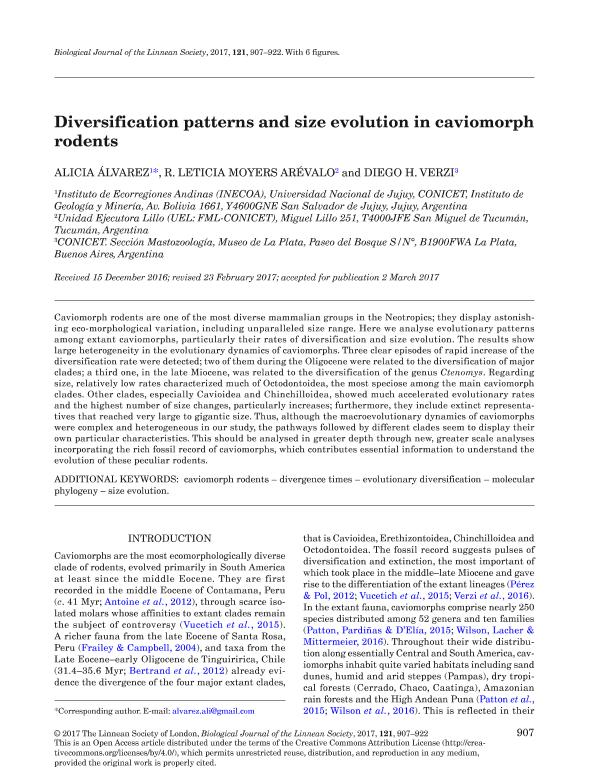Mostrar el registro sencillo del ítem
dc.contributor.author
Alvarez, Alicia

dc.contributor.author
Moyers Arévalo, Reyna Leticia

dc.contributor.author
Verzi, Diego Hector

dc.date.available
2018-11-16T14:07:19Z
dc.date.issued
2017-08
dc.identifier.citation
Alvarez, Alicia; Moyers Arévalo, Reyna Leticia; Verzi, Diego Hector; Diversification patterns and size evolution in caviomorph rodents; Oxford University Press; Biological Journal of The Linnean Society; 121; 4; 8-2017; 907-922
dc.identifier.issn
0024-4066
dc.identifier.uri
http://hdl.handle.net/11336/64581
dc.description.abstract
Caviomorph rodents are one of the most diverse mammalian groups in the Neotropics; they display astonishing eco-morphological variation, including unparalleled size range. Here we analyse evolutionary patterns among extant caviomorphs, particularly their rates of diversification and size evolution. The results show large heterogeneity in the evolutionary dynamics of caviomorphs. Three clear episodes of rapid increase of the diversification rate were detected; two of them during the Oligocene were related to the diversification of major clades; a third one, in the late Miocene, was related to the diversification of the genus Ctenomys. Regarding size, relatively low rates characterized much of Octodontoidea, the most speciose among the main caviomorph clades. Other clades, especially Cavioidea and Chinchilloidea, showed much accelerated evolutionary rates and the highest number of size changes, particularly increases; furthermore, they include extinct representatives that reached very large to gigantic size. Thus, although the macroevolutionary dynamics of caviomorphs were complex and heterogeneous in our study, the pathways followed by different clades seem to display their own particular characteristics. This should be analysed in greater depth through new, greater scale analyses incorporating the rich fossil record of caviomorphs, which contributes essential information to understand the evolution of these peculiar rodents.
dc.format
application/pdf
dc.language.iso
eng
dc.publisher
Oxford University Press

dc.rights
info:eu-repo/semantics/openAccess
dc.rights.uri
https://creativecommons.org/licenses/by-nc-sa/2.5/ar/
dc.subject
Caviomorph Rodents
dc.subject
Divergence Times
dc.subject
Evolutionary Diversification
dc.subject
Molecular Phylogeny
dc.subject
Size Evolution
dc.subject.classification
Otras Ciencias Biológicas

dc.subject.classification
Ciencias Biológicas

dc.subject.classification
CIENCIAS NATURALES Y EXACTAS

dc.title
Diversification patterns and size evolution in caviomorph rodents
dc.type
info:eu-repo/semantics/article
dc.type
info:ar-repo/semantics/artículo
dc.type
info:eu-repo/semantics/publishedVersion
dc.date.updated
2018-10-23T20:53:00Z
dc.journal.volume
121
dc.journal.number
4
dc.journal.pagination
907-922
dc.journal.pais
Reino Unido

dc.journal.ciudad
Londres
dc.description.fil
Fil: Alvarez, Alicia. Universidad Nacional de Jujuy. Instituto de Ecorregiones Andinas. Consejo Nacional de Investigaciones Científicas y Técnicas. Centro Científico Tecnológico Conicet - Salta. Instituto de Ecorregiones Andinas; Argentina
dc.description.fil
Fil: Moyers Arévalo, Reyna Leticia. Consejo Nacional de Investigaciones Científicas y Técnicas. Centro Científico Tecnológico - Tucumán. Unidad Ejecutora Lillo; Argentina
dc.description.fil
Fil: Verzi, Diego Hector. Universidad Nacional de La Plata. Facultad de Ciencias Naturales y Museo; Argentina. Consejo Nacional de Investigaciones Científicas y Técnicas; Argentina
dc.journal.title
Biological Journal of The Linnean Society

dc.relation.alternativeid
info:eu-repo/semantics/altIdentifier/url/https://academic.oup.com/biolinnean/article/121/4/907/3095993
dc.relation.alternativeid
info:eu-repo/semantics/altIdentifier/doi/https://doi.org/10.1093/biolinnean/blx026
Archivos asociados
